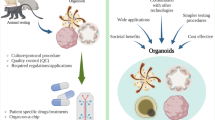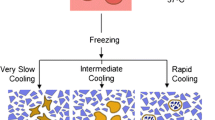Abstract
To investigate the effects of different states of donor cells on the development of reconstructed sheep embryos, we designed five treatments of donor cells, including cell passage, cell size, serum starvation, colchicine treatment and gene transfection. Results are as follows: (I) Compared with 16–18 passage cells, the morula/blastocyst rate of 5–7 passage cells as donor nuclei was significantly higher (17.3% vs. 4.9%, P<0.05), suggesting the advantage of short-time cultured cells in supporting the development of reconstructed embryos. (II) The mourla/blastocyst rate of reconstructed embryos derived from medium cells (15–25 μm) as donor nuclei was higher than that from large cells (25–33 μm) and small cells (8–15 μm)(20.0% vs. 8.0%, 9.7%), indicating that reconstructed embryos from medium cells had a greater potentiality to develop into morula/blastocysts than those from small or large ones. (III) The morula/blastocyst rate of reconstructed embryos from donor cells of SS (serum starvation) was lower than that from donor cells of NSS (non-serum starvation), but no significant difference was detected between SS and NSS(11.8% vs. 18.6%, P>0.05). (IV) Fetal fibroblasts treated with 0.05 μmol/L colchicine exhibited a higher morula/blastocyst rate of reconstructed embryos than those treated with 0.10 μmol/L colchicine and untreated ones (27.5% vs. 12.1%, 17.1%), however, no significant difference among the three treatments was detected (P>0.05). (V) The morula/blastocyst rate of reconstructed embryos from fetal fibroblasts transfected with GFP gene only was 3.1%, significantly lower than that from non-transgenic cells (3.1% vs. 20.4%, P<0.05). In conclusion, our results demonstrated that fetal fibroblasts of fewer passages, medium size could ensure a higher morula/blastocyst rate of reconstructed embryos. Serum starvation of donor cells might be unnecessary to the development of reconstructed embryos. Donor cells treated with 0.05 μmol/L colchicine could facilitate the development of reconstructed embryos. Additionally, as cells transfected with GFP gene were used as donor nuclei, adverse effect on the development of reconstructed embryos was observed. Therefore, the developmental efficiency of reconstructed embryos could be improved if proper treatments to donor cells were used.
Similar content being viewed by others
References
Willmut I, Schnieke A E, McWhir J, et al. Viable offspring derived from fetal and adult mammalian cells. Nature, 1997, 385: 810–813
Baguisi A, Behboodi E, Melican D T, et al. Production of goat by somatic cell nuclear transfer. Nature Biotech, 1999, 17: 456–461
Wakayama T, Rerry A C F, Zuccotti M, et al. Full-term development of mice from enucleated oocytes injected with cumulus cell nuclei. Nature, 1998, 392(23): 369–374
Kato Y, Tani T, Sotomaru Y, et al. Eight calves cloned from somatic cells of a single adult. Science, 1998, 282: 1975–1976
Onishi A, Iwamoto M, Akita T, et al. Pig cloning by microinjection of fetal fibroblast nuclei. Science, 2000, 289: 2095–2097
Galli C, Lagutina I, Crotti G, et al. Pregnancy: a cloned horse born to its dam twin. Nature, 2003, 424: 635.
Woods G L, White K L, Vanderwall D K, et al. A mule cloned from fetal cells by nuclear transfer. Science, 2003, 301(5636): 1063.
Shin T, Kraemer D, Pryor J, et al. A cat cloned by nuclear transplantation. Nature, 2002, 415: 859
Chesne P, Adenot P G, Viglietta C, et al. Cloned rabbits produced by nuclear transfer from adult somatic cells. Nat Biotechnol, 2002, 20(4): 366–369
Zhou Q, Renard J P, Le Friec G, et al. Generation of fertile cloned rats by regulating oocyte activation. Science, 2003, 302: 1179
Lee B C, Kim M K, Jang G, et al. Dogs cloned from adult somatic cells. Nature, 2005, 436(7051): 641
Colman A. Somatic cell nuclear transfer in mammals: Progress and applications. Cloning, 2000, 1: 185–200
Oikawa T, Numabe T, Sunoda T, et al. Production of somatic cell clone calves from cumulus cell of a 20 year old Japanese black cow. Theriogenology, 2000, 53: 236 (abstract)
Wells D N, Misica P M, Tervit H R. Production of cloned calves following nuclear transfer with cultured adult mural granulose cell. Biol Reprod, 1999, 60: 996–1005
Shiga K, Fujita T, Hirose K, et al. Production of calves by transfer of nuclei from cultured somatic cells obtained from Japanese black bulls. Theriogenology, 1999, 38: 897–904
Ogura A, Inoue K, Ogonuki N. et al. Production of male cloned mice from fresh cultured and cryopreserved immature sertoli cells. Biol Reprod, 2000, 62: 1579–1584
Cibelli J B, Stice S L, Golueke P J, et al. Cloned transgenic calves produced from nonquiescent fetal fibroblasts. Science, 1998, 289: 1256–1258
Schnieke A E, kind A J, Ritchie W A, et al. Human factor IX transgenic sheep produced by transfer of nuclei from transfected fetal fibroblasts. Science, 1997, 278: 2130–2133.
Zakhartchenko V, Durcova Hills G, Stojkovic M, et al. Effects of serum starvation and recloning on the efficiency of nuclear transfer using bovine fetal fibroblasts. J Reprod Fertil, 1999, 115(2): 325–331
Lai L X, Park K W, Cheong H T, et al. Transgenic pig expressing the enhanced green fluorescent protein produced by nuclear transfer using colchicines-treated fibroblasts as donor cells. Mol Reprod Dev, 2002, 62(3): 300–306
Reggio B C, James A N, Green H L, et al. Cloned transgenic offspring regulating from somatic cell nuclear transfer in the goat: oocytes derived from both follicle-stimulating hormone stimulated and non-stimulated abattoir-derived ovaries. Biol Reprod, 2001, 65: 1528–1533
Kubota C, Yamakuchi H, Todorki J, et al. Six cloned calves produced from adult fibroblast cells after long-term culture. Proc Natl Acad Sci USA, 2000, 97(3): 990–995
Prather R S. Cloning. Pigs is pigs. Science, 2000, 289: 1886–1887
Gong G, Dai Y, Fan B, et al. Birth of calves expressing the enhanced green fluorescent protein after transfer of fresh or vitrified/thawed blastocysts produced by somatic cell nuclear transfer. Mol Reprod Dev, 2004, 69: 278–288
E Z. Tissue Culture and Molecular Biotechnology (in Chinese). Beijing: Beijing Press, 1994
Andrew C, Boqiest, Billy N, et al. Flow cytometric cell analyses of cultured fetal fibroblast cells. Biol Reprod, 1999, 60: 1013–1019
Mohamed Nour M S, Ikeda K, Takahashi Y. Bovine nuclear transfer using cumulus cells derived from serum-starved and confluent cultures. J Reprod Dev, 2000, 46: 85–92.
Wells D N, Misica P M, Day A M, et al. Production of cloned lambs from an established embryonic cell line: a comparison between in vivo and in vitro-matured cytoplasts. Biol Reprod, 1997, 57: 385–393.
Campbell K H S, Ritchie W A, Wilmut I. Nuclear-cytoplasmic interactions during the first cell cycle of nuclear transfer reconstructed bovine embryos: implication for deoxyribonucleic acid replication and development. Biol Reprod, 1993, 49: 932–942
Campbell K H S, McWhir J, Ritchie W A, et al. Sheep cloned by nuclear transfer from a cultured cell line. Nature, 1996b, 380: 64–66
Keefer C L, Keyston R, Lazaris A, et al. Production of cloned goats after nuclear transfer using adult somatic cells. Biol Reprod, 2002, 66: 199–203
Hill J R, Winger Q A, Long C R, et al. Development rates of male bovine nuclear transfer embryos derived from adult and fetal cells. Biol Reprod, 2000, 62: 1135–1140
Vignon X, LeBourshis D, Chesne P, et al. Development of bovine nuclear transfer embryos reconstituted with quiescent and proliferative skin fibroblasts. Theriogenology, 1999, 51: 216 (abstract)
Hyun S, Lee G, Kim D, et al. Production of nuclear transfer-derived piglets using porcine fetal fibroblasted with the enhanced green fluorescent protein. Biol Reprod, 2003, 69: 1060–1068
Edwards J L, Dorado C M, Wilson T J, et al. Development of cloned embryos reconstructed with serum fed or serum starved adult granulosa cells. Theriogenology, 2001, 55: 265
Kues W A, Anger M, Carnwath J W, et al. Cell cycle synchronization of porcine fetal fibroblasts: Effects of serum deprivation and reversible cell cycle inhibitors. Biol Reprod, 2000, 62: 412–419
Liu L, Dai Y, Moor R M. Nuclear transfer in sheep embryos: the effect of cell-cycle coordination between nucleus and cytoplasm and the use of in vitro mature oocytes. Mol Reprod Dev, 1997, 47: 255–264
Zhou Q, Jouneau A, Brochard V, et al. Developmental potential of mouse embryos reconstructed from metaphase embryonic stem cell nuclei. Biol Reprod, 2001, 65: 412–419
Amano T, Tani T, Kato Y, et al. Mouse cloned from embryonic stem (ES) cells synchronized in metaphase with nocodazole. J Exp Zool, 2001, 289: 139–145
Guo G Q, Zhen G C. Study on molecule biology characters of GFP in viable cell. Research and Development of World Science and Technology (in Chinese). 1998, 1: 70–75
Park K W, Cheong H T, Lai L, et al. Production of nuclear transfer-derived swine that express the enhanced green fluorescent protein. Anim Biotechnol, 2001, 12: 173–181
Author information
Authors and Affiliations
Corresponding authors
Additional information
Supported by the National Key Basic Research ‘973’ Program of China (Grant No. 2006CB102100) and Project of Agricultural Structure Adjustment of China (Grant No. 05-07-04B)
Rights and permissions
About this article
Cite this article
Wang, H., Ao, H., Pan, Q. et al. Effects of different states of sheep fetal fibroblasts as donor cells on the early development in vitro of reconstructed sheep embryos. SCI CHINA SER C 50, 178–185 (2007). https://doi.org/10.1007/s11427-007-0013-5
Received:
Accepted:
Issue Date:
DOI: https://doi.org/10.1007/s11427-007-0013-5




